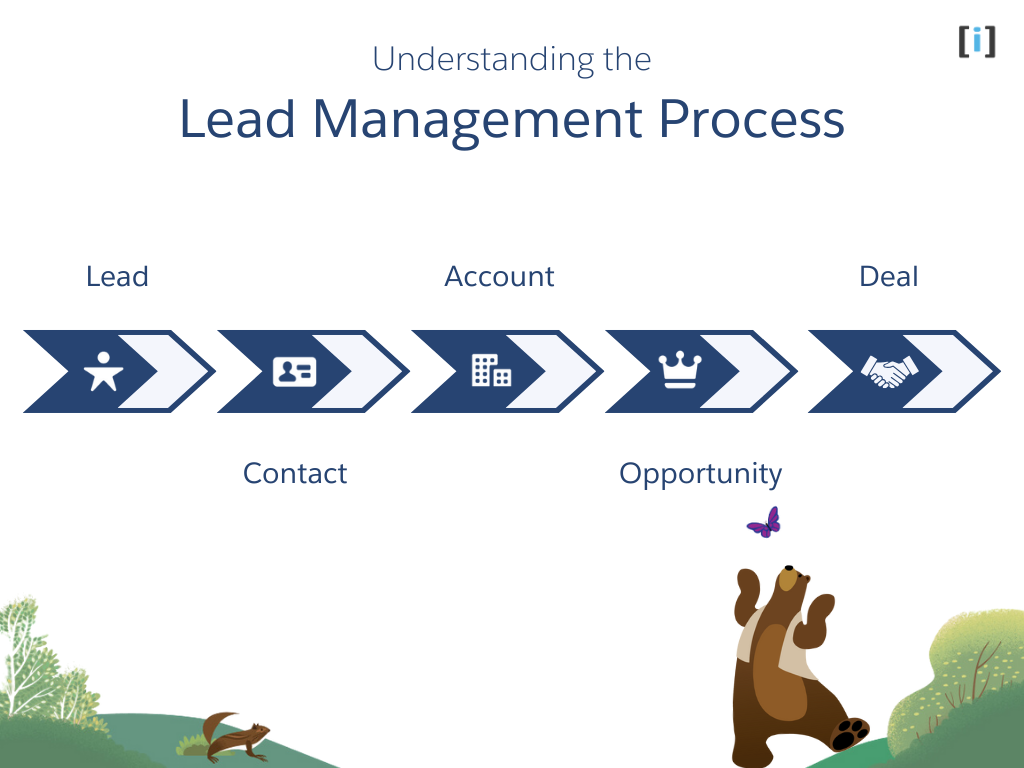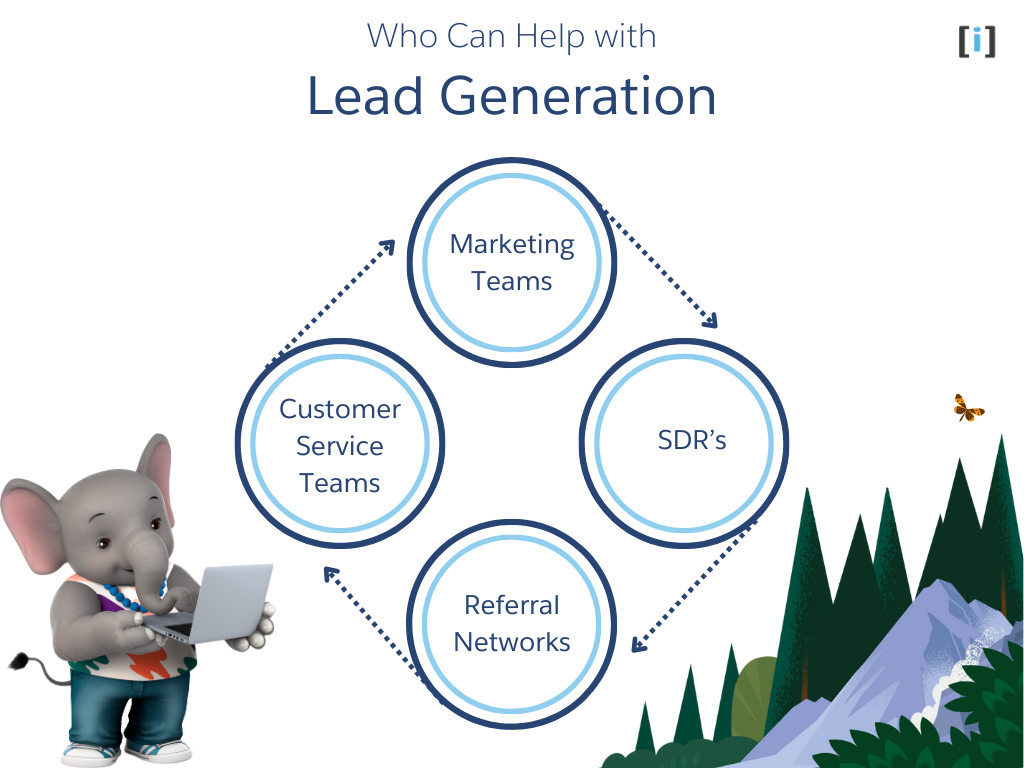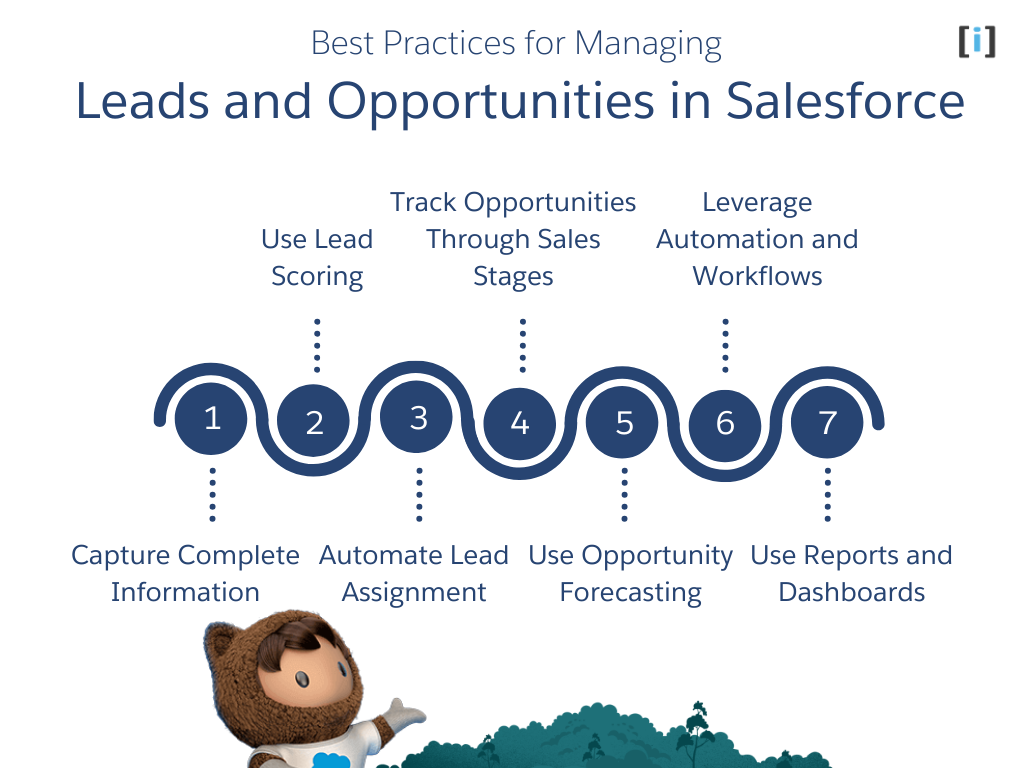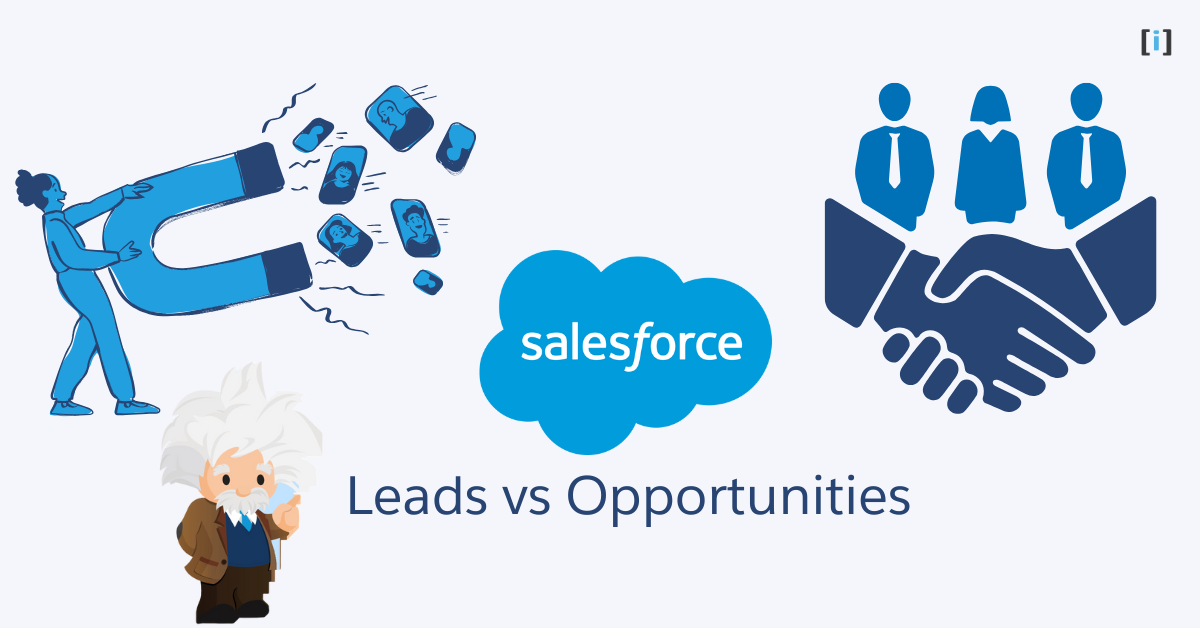In the world of sales, managing potential customers effectively can make or break your business.
In Salesforce, two key terms you’ll often come across are “Leads” and “Opportunities.” While both represent prospects and they are at different stages in the sales journey. Understanding Salesforce Leads vs Opportunities is key to converting more leads into successful deals.
In this post, we’ll explain what leads and opportunities are, how they differ, and why it’s important to manage them properly. This guide will help you understand it easily!
Understanding the Lead Management Process in Salesforce

Before we talk about the difference between leads and opportunities, it’s important to first understand the lead management process in Salesforce. This process helps you move from finding a lead to hopefully closing a sale.
Salesforce lead management has five key steps: Lead, Contact, Account, Opportunity, and Deal. Each step helps you move closer to making a sale. Let’s take a closer look at each of these steps.
Lead
In Salesforce, a lead is a potential customer who hasn’t been qualified yet. This means you’re not sure if they’re interested in buying from you or not. It’s like a name on a list that you plan to follow up on.
Contact
Once you find out that a lead is genuinely interested and could be a good fit for your product or service, the lead becomes a contact. A contact is someone who is willing to talk more about your business and possibly buy from you.
Account
An account is a company or business, not an individual. It’s the organization you want to sell to. There can be multiple people (contacts) at an account who you can talk to about making a sale.
Explore the Ultimate Guide to Managing Accounts in Salesforce.
Opportunity
An opportunity is a possible sale. When you believe that a contact or account might actually make a purchase, you create an opportunity. This means there’s a real chance that the deal will happen.
Discover all you need to know about Salesforce Opportunities in our detailed guide.
Deal
Finally, when an opportunity turns into a deal, the customer has decided to buy from you. This is the goal of the entire process, closing the sale!
What are Salesforce Leads?
In Salesforce, a Lead is essentially a potential sales contact, someone who has shown interest in your products or services but hasn’t yet been fully qualified. Leads are gathered through various marketing efforts such as advertisements, online forms, trade shows, or referrals. These early-stage prospects represent potential customers, but their specific needs and likelihood of making a purchase haven’t been fully determined yet.
Key Characteristics of Leads
Unqualified
Leads are not yet confirmed as likely buyers; they are in the initial “interest” phase.
Initial Contact
A lead might be someone who filled out a contact form or was referred to your business.
Capture Information
The goal at this stage is to collect basic details such as the lead’s name, email, company, and specific interest in your products or services.
Lead Process in Salesforce
The Lead Process is a series of steps that help you capture, qualify, and convert potential customers (leads) into valuable business opportunities. It provides a structured approach to managing the early stages of your sales cycle.
Lead Creation
A lead is created in Salesforce when a prospect shows interest in your business.
Lead Qualification
The lead is evaluated using criteria like budget, authority, need, and timing (BANT) to determine if they should move forward in the sales process.
Lead Conversion
If the lead meets specific criteria and shows more potential, they can be converted into an Opportunity.
Leads in Salesforce represent early-stage contacts that may turn into paying customers, but further action is required to qualify them and move them forward in the sales funnel.
Key Lead Terms
Lead Qualification
The process of determining how likely a lead is to convert into a paying customer.
Lead Status
A status assigned to each lead. Salesforce includes statuses like Open, Contacted, Qualified, and Unqualified.
Lead Process
The steps of creating, nurturing, and transferring leads to sales reps to convert them into opportunities.
What is an Opportunity?
An Opportunity in Salesforce represents a potential deal with a qualified lead, someone who has shown genuine interest and has a higher likelihood of making a purchase. Once a lead is qualified and considered a potential customer, it is converted into an opportunity. Opportunities are tied to specific products or services.
Key Characteristics of Opportunities
Qualified
Opportunities are leads that have been checked and are ready for the next step in the sales process.
Revenue-Focused
Opportunities are tied to specific sales values, projected close dates, and are associated with the potential for generating revenue.
Active Negotiation
At this stage, the sales team talks to the customer, shows product demos, and works out details to close the deal.
Sales Stages
Opportunities go through different stages like “Prospecting,” “Qualification,” “Proposal,” and “Negotiation,” until they are either “Closed Won” (deal won) or “Closed Lost” (deal lost).
Forecasting
Opportunities help businesses to predict future sales and manage the sales process more effectively.
Sales Focus
Opportunities are closely managed by the sales team and are tracked for detailed forecasting and sales management.
Higher Chance of Closing
Opportunities are more likely to become actual sales compared to leads, so the sales team focuses on them more.
Opportunity(Sales) Process in Salesforce
The Sales Process in Salesforce is the series of steps a sales team follows to turn a potential customer into a paying one. It helps track where the customer is in the process, from the first interest to closing the sale.
Learn more about the sales process in Salesforce, how to create it, and its benefits.
Opportunity Creation
After a lead is converted, an opportunity is created. Here, the sales team can track essential details such as expected value, close date, and sales stage.
Sales Stages
Opportunities progress through stages like “Prospecting,” “Qualification,” “Proposal,” “Negotiation,” and finally, “Closed Won” or “Closed Lost.”
Learn more about opportunity stages in Salesforce.
Closing the Deal
The ultimate goal is to either win the opportunity by closing the deal or lose it due to various reasons like budget constraints, timing, or decision-making.
An opportunity in Salesforce is a potential customer who is serious about making a purchase. It goes through different stages of the sales process, where your team works to negotiate and close the deal.
Salesforce Leads vs Opportunities
Understanding the difference between leads and opportunities is important for effective sales and marketing because they are different stages in the process of attracting customers, and each needs a different approach. Here’s why:
Focused Resource Allocation
When sales teams identify opportunities, they can focus on people who are more likely to become customers. This helps them use their time and energy wisely. At the same time, marketing teams can create campaigns that help move leads towards becoming opportunities.
Better Sales Predictions
Knowing the difference also helps with predicting future sales. By looking at opportunities, sales leaders can guess how much money will come in the future. If they see leads are getting stuck, they can fix those issues to improve the sales process.
Better Customer Experience
Focusing on opportunities also makes the customer experience better. When you talk to them in a way that matches their needs, they feel understood and are more likely to buy. Giving priority to opportunities also helps make sure you follow up with them at the right time, which speeds up the process of making a sale.
Making Smarter Decisions with Data
By tracking how leads become opportunities and how opportunities turn into sales, businesses can make smarter decisions. They can find out what’s working well and what needs improvement, and they can spot patterns that help improve future strategies.
Here’s a simple comparison of the main differences between leads and opportunities. It shows how leads and opportunities are treated differently.
| Area of the Difference | Leads | Opportunities |
|---|---|---|
| Stage | Earliest stage in the sales cycle | A later stage, when the lead is more promising |
| Information | It contain basic contact details like name, email. | It include more detailed information like deal size, sales stage, close date. |
| Purpose | Identifying the potential customers | Tracking the progress of qualified prospects |
| Conversion Process | Leads can be converted into contacts, accounts, or opportunities once they show higher interest | Opportunities come from leads that have been qualified and seem ready to close |
| Sales Tracking | Helps measure how well marketing and lead generation are working | Tracks the progress of potential sales and their chances of closing |
Who Can Help with Lead Generation?

Lead generation isn’t just the responsibility of one team, it involves collaboration across various roles. Each group within your business plays a part in finding and gathering leads. Here’s how different teams can help with lead generation:
Marketing Teams
Marketing is usually the main driver for lead generation. They create campaigns, ads, and content that attract potential customers to your business. Marketing also manages public forms on websites and landing pages to capture leads’ contact details.
Sales Development Representatives (SDR’s)
SDR’s play a key role in qualifying leads. They often follow up on inbound leads (such as those from a form submission or ad response) to see if they’re ready for deeper engagement. They also reach out to prospects through cold calling or email outreach to generate new leads.
Customer Service Teams
Customer service can identify potential leads through existing customers who may need additional services or new products. They might suggest an upgrade or share a referral program with customers who are happy with the service.
Referral Networks
When happy customers or business partners tell others about your products or services, it can bring in new leads. Encouraging your satisfied customers to refer their friends, family, or colleagues can be a great way to generate more leads. People are more likely to trust recommendations from someone they know, making this a powerful way to find new prospects.
Ways to Generate Leads
There are multiple ways to generate leads, and technology has made it easier than ever to gather information. Here are some key methods businesses use to generate leads:
Public Forms
A public form is a simple way to collect information from potential leads. These forms are often found on your website, landing pages, or social media. They usually ask for basic details. When someone fills out the form, they become a lead that your sales team can contact.
Discover how Salesforce provides resources to easily create and manage public forms.
Web-to-Lead in Salesforce
One helpful tool for generating leads in Salesforce is called Web-to-Lead. This allows you to add a form to your website, and when someone fills it out, their information is automatically sent into Salesforce as a new lead.
Learn everything about Web to Lead in Salesforce with our detailed guide.
Checkout how to add a Salesforce Web to Lead form on your WordPress website.
Third-Party Apps and Integrations
There are many third-party apps that can help you generate leads and work with your CRM. Include Gravity Forms, Form Assembly, JotForm, and Google Forms. These tools can collect lead information and integrate it directly into your system.
Learn how to utilize Gravity Forms, FormAssembly, and Google Forms in Salesforce.
Turn a Lead into an Opportunity
Now comes the Salesforce part! Once you’ve generated a lead and had enough conversations to qualify them, and you feel they might be ready to make a purchase, it’s time to turn that lead into an opportunity.
In Salesforce, this process is called “Lead Conversion.” Here’s how it works in simple steps:
- When to Convert a Lead: You should convert a lead when you’ve gathered enough information, and the lead shows genuine interest in purchasing.
- Why Convert a Lead: Converting a lead to an opportunity moves the prospect to a more serious stage of the sales process. It means you’re confident they are worth pursuing and are likely to close a deal.
- How to Convert a Lead in Salesforce:
- Open the lead in Salesforce.
- Click on the “Convert” button.
- Salesforce will create a new Account, Contact, and Opportunity for the lead. The opportunity will be linked to the converted contact and account.
Checkout to learn all about the lead conversion in Salesforce.
Note: Lead conversion can only happen once. Once a lead is converted into an opportunity, you cannot undo this action.
Best Practices for Managing Leads and Opportunities in Salesforce

By following these best practices, you can manage your leads and opportunities in Salesforce more effectively and increase your chances of converting prospects into long-term customers.
Capture Complete Information
Ensure that all lead and opportunity records in Salesforce contain complete and accurate information.
Use Lead Scoring
Lead scoring helps you prioritize leads based on their engagement and fit. By assigning scores to leads based on factors like interaction level, company size, or industry, you can focus on the leads with the most potential and avoid spending time on less valuable ones.
Automate Lead Assignment
Set up rules for automatically assigning leads to the right sales reps based on criteria like location, product interest, or lead source. This helps you follow up on time and reduces the chance of leads being missed.
Track Opportunities Through Sales Stages
Once a lead is converted into an opportunity, track its progress through the different sales stages. Use Salesforce’s customizable sales stages to map out your sales process, from prospecting to closing.
Use Opportunity Forecasting
Keep track of the value and chances of closing each opportunity. Salesforce helps you follow deal values, expected close dates, and sales stages, so you can see where each opportunity stands and adjust your plan when needed.
Leverage Automation and Workflows
Automate tasks like sending follow-up emails, setting reminders, and nurturing leads. Salesforce tools like process builder, flows and email templates help simplify these tasks and ensure follow-ups happen on time, saving time and boosting efficiency.
See how Salesforce email automation can enhance your email sending process.
Use Reports and Dashboards
Use Salesforce’s reports and dashboards to track your leads and opportunities. Monitor key numbers like how many leads convert into customers and how often deals close. This helps you make smarter decisions and improve your sales strategy.
Conclusion
In sales, managing potential customers is key to a business’s success, and understanding the difference between Leads and Opportunities in Salesforce is essential. Leads represent the early stage of customer interest, while Opportunities show prospect is ready to move forward in the sales process. By properly managing both, businesses can prioritize efforts, improve sales forecasts, and close more deals.
Converting Leads into Opportunities and following best practices can improve efficiency and increase the chances of turning prospects into loyal customers.
Additional Related Links
Try the Salesforce Web-to-Lead Form Builder for free
Explore the top 10 web forms that work with Salesforce integration.
Discover 3 Salesforce web forms that help you customize your data collection.
FAQs
What is the main difference between a lead and an opportunity in Salesforce?
A lead is a potential customer who hasn’t yet been qualified, while an opportunity represents a qualified lead that has a higher chance of turning into a sale.
How do I generate leads in Salesforce?
You can generate leads in Salesforce using public forms on your website, Web-to-Lead forms that automatically capture and enter information, or through third-party apps that integrate with Salesforce.
Can I track both Leads and Opportunities in Salesforce?
Yes, Salesforce allows you to track both Leads and Opportunities separately, making it easier to manage your sales process and monitor the progress of potential customers.
When should I convert a lead into an opportunity?
You should convert a lead when you’ve gathered enough information, and the lead shows genuine interest in purchasing. This means the lead is now ready for more serious discussions.
What happens after a lead is converted into an opportunity?
After a lead is converted, it becomes an Opportunity in Salesforce. The opportunity goes through different stages, such as prospecting, qualification, proposal, and negotiation, until it is either closed won or closed lost.
Can I undo a lead conversion in Salesforce?
No, once a lead is converted into an opportunity, it cannot be undone. This is why it’s important to ensure that the lead is truly ready to move to the next stage before converting.
